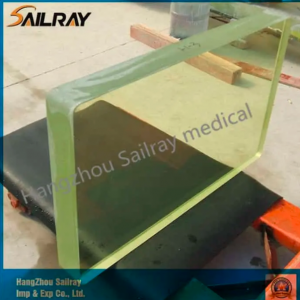In the fast-paced world of medical diagnosis and treatment, technological advancements have become key to ensuring accurate and efficient healthcare practice. Among these breakthroughs, X-ray shielding lead glass became an indispensable tool in the medical industry. This blog will delve into the many applications and benefits of X-ray shielding lead glass, showing how it can play an important role in protecting patients and medical professionals during X-ray procedures.
What is X-ray shielding lead glass?
X-ray shielding lead glass, also known as radiation shielding or leaded glass, is specifically designed to contain and reduce radiation exposure. It consists of a mixture of glass and lead oxide, with a high concentration of lead in the glass composition. This formula enables it to block X-rays and gamma rays, protecting individuals who are exposed to radiation.
Applications in the medical industry:
1. X-ray imaging room:
X-ray shielding lead glass plays a leading role in the construction of professional X-ray imaging rooms. These rooms are equipped with lead-lined walls and floors to ensure proper radiation containment. Inside these protected chambers, lead glass provides a transparent barrier between patients and healthcare professionals. It allows doctors to observe and pinpoint patients while protecting themselves from harmful radiation.
2. Radiation therapy:
In cancer treatment, radiation therapy is a commonly used technique to target and destroy tumor cells. X-ray shielding lead glass is critical in radiation therapy rooms as it provides a protective barrier for treated patients and medical staff. When X-rays are emitted during treatment, lead glass effectively absorbs and blocks the radiation, reducing the risk of exposure to the surrounding area.
3. Nuclear medicine:
Nuclear medicine deals with the management of radioactive materials for diagnostic and therapeutic purposes. X-ray shielding lead glass is widely used in rooms where radioactive materials are stored, prepared or managed. These glass panels provide excellent radiation protection, ensuring the safety of medical professionals when handling and preparing radioactive materials.
Advantages of X-ray shielding lead glass:
1. Radiation containment:
The main advantage of X-ray shielding lead glass is its ability to effectively suppress radiation. By effectively blocking X-rays and gamma rays, it prevents the spread of harmful radiation beyond controlled areas, minimizing risk to patients and medical professionals.
2. Transparency:
X-ray shielding lead glass remains transparent despite the high lead content. This transparency allows physicians to maintain visual contact with patients during imaging or treatment, facilitating accurate diagnosis and treatment processes.
3. Durability:
X-ray shielding lead glass is extremely durable and resistant to environmental elements, ensuring the longevity and consistency of its radiation shielding function. Its ruggedness allows it to withstand the rigors of healthcare environments, providing reliable protection for years to come.
in conclusion:
In the medical industry, the safety and well-being of patients and healthcare professionals is paramount. X-ray shielding lead glass plays an integral role in protecting individuals from harmful radiation exposure. It is an essential part of building purpose-built rooms and facilities dedicated to X-ray imaging, radiation therapy and nuclear medicine. With its superior radiation containment capabilities and transparency, X-ray shielding lead glass remains an invaluable resource for protecting the health and safety of personnel in all medical procedures involving radiation.
Post time: Aug-04-2023



